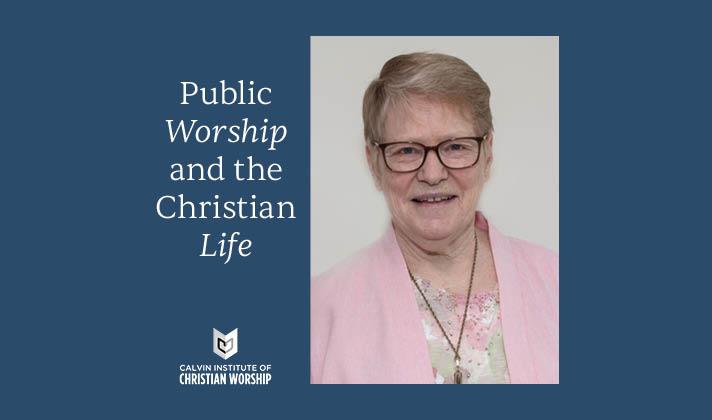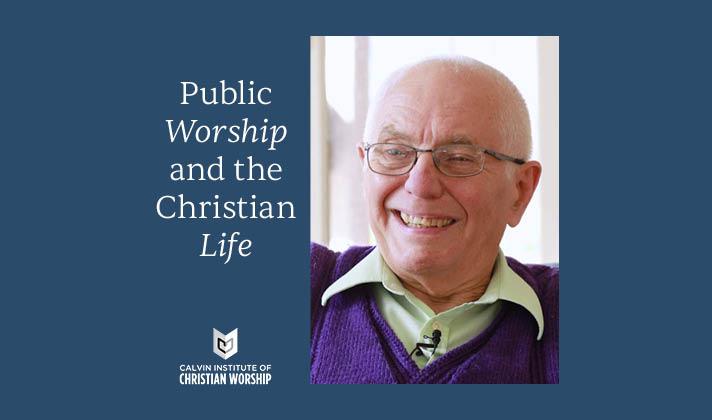Psalms For All Seasons is a major collection of psalms for use in worship. This festival explores the full spectrum of singing the psalms crossing boundaries of time and tradition.
Hosted by Martin Tel, with leadership from many Symposium on Worship presenters.
Pa-Salms image by Joel Schoon-Tanis.
Program
92A It Is Good to Sing Your Praises
The 1912 Psalter is arguably the most influential metrical Psalter published in the United States. Many of these psalm settings continue to be sung in Reformed and Presbyterian congregations. Part of what makes these settings so endearing and enduring is the perfect match between the text and tune. They are as enjoyable to sing in 2012 as they were in 1912!
92B Mah Gadlu / Oh, How Great Are Your Works
The 25 languages represented in PFAS hint at the hundreds of languages in which the Psalms are sung today. Mah Gadlu reminds us of the original language in which the book of Psalms was sung. In this setting, the Jewish rabbi Shefa Gold invites us to sing with resonant, low voices, allowing Torah, God’s Word, to dwell deeply in us.
127B Unless the Lord Builds the House
Of the many ways we can sing the psalms, unison chant is probably the closest we come to the ancient practice of psalm singing. Recently the chanting of psalms has been fused with jazz, modern, and popular genres. Chanting does not belong to any one tradition—any congregation can chant the psalms together. The best way to learn to chant is to listen to others (a cantor or an ensemble, for example) and then jump in! Gregg DeMey is pastor of the Elmhurst Christian Reformed Church in Illinois. He composed this refrain for PFAS.
46E God Is Our Refuge and Strength
Many churches in the Anglican and Episcopal traditions chant the psalms in four parts. Those not comfortable with singing in parts should simply sing the melody (top line). The melody for this chant is drawn from Martin Luther’s famous chorale, A Mighty Fortress Is Our God. Rather than sing a ‘hymn-like’ version of the psalm, here we sing a straight translation from the Hebrew (from The Book of Common Prayer). It is akin to speaking the text together, but with pitches.
131B In You, O Lord, I Have Found My Peace
David Haas’ music exemplifies well the folk approach to singing that has emerged from Roman Catholic communities and composers. The easily sung refrain makes the psalm accessible to the congregation and moves singers right to the heart of the psalm. A setting for cantor, choir, and instruments is available from GIA Publications (G-2924).
77B I Refused to Be Comforted Easily
While the congregation could sing this song together, it is an individual song of lament. John Bell suggests that it may be communicated most clearly if the stanzas are heard as a single voice and the congregation joins in the singing of the refrain. A setting for cantor, piano, and choir is available from GIA Publications (G-8014).
120C O God of Love, Forever Blest
Bruce Benedict is Director of Worship and Community Life at Christ the King Presbyterian Church in Raleigh, NC. He is also the founder of Cardiphonia, a collaborative venture for worship arts. He recently led his church through the Psalms of Ascent (Pss. 120-134). When exploring these psalms, many choose to skip Ps. 120. It seems at first to be a real ‘nonstarter!’ But the journey begins with honest statements of fears and anxieties. Bruce introduced Ps. 120 to his church by dusting off an old Isaac Watts versification of the psalm (originally titled “Thou God of Love”) and resetting it with original music. Linea Reimer Geiser, a poet from the Mennonite tradition, wrote the closing prayer which both laments the ravages of war and hopes for peace.
97A God Reigns! Earth Rejoices!
Psalm 97 is traditionally associated with both Christmas and Easter. The tune NOËL NOUVELET helps to solidify these associations. During Christmas the tune accompanies the text “Sing We Now of Christmas” and in Easter “Now the Green Blade Rises.” In his collection of metrical psalm texts, Psalter for Christian Worship (Witherspoon Press, rev. ed. 2010), Michael Morgan had a text for Ps. 97 that matched the spirit of this joyful tune. We asked if he would consider adapting the meter of this text so that it could be sung to NOËL NOUVELET. He did even better—he composed an inspiring new text that highlights both the Christmas and Easter imagery found in the psalm.
121E I to the Hills Will Lift My Eyes
The 1912 Psalter supplied several metrical texts for Ps. 121. In later Psalters and hymnals, some denominations (including the Christian Reformed Church) favored “To the Hills I Lift My Eyes” to the tune GUIDE (see 121A in PFAS). The majority of Presbyterian publications, however, kept to this versification. Originally paired with the tune ST. AGNES, it is set here with an old Appalachian melody, UNION. The beautiful and unobtrusive harmonization is by Alice Parker as found in her Melodious Accord Hymnal (distributed by GIA Publications, 2010, G-7912).
121F Naega sanul hyanghayo / To the Hills I Lift My Eyes
In 1990 the Christian Conference of Asia and the Asian Institute for Liturgy and Music co-published the first edition of Sound the Bamboo, a hymnal of world music compiled specifically for Asian Christians. This hymnal, and its subsequent updated 2000 version (distributed by GIA Publications, G-6830), has introduced Christians around the world to countless songs from Asian churches. I-to Loh, the general editor of the collection, is a stalwart proponent of singing these Asian songs in Asian ways, resisting efforts to make them sound more “Western.” Introducing “Asian singing” is better caught than taught. We listen first and then join in the song. With the help of Korean seminary students at Calvin Seminary, Emily Brink produced this fresh English translation for PFAS.
27B The Lord Is My Light
This setting by Lillian Bouknight arises from the Black gospel tradition. It works equally well as a solo, a choir anthem, or as a congregational song. In any case, all will want to sing the refrain. As is true of much of the music from the African American traditions, the performance of the song varies widely from region to region, and even from one congregation to the next. The music as it is printed on the page is simply one approximation. Rather than rigidly following the notes, harmony, and rhythm on the page, follow the leaders of the song.
42A Como el ciervo / Like a Deer
As the preparation of PFAS was concluding in the summer of 2011, a group of native Spanish speakers gathered in Princeton, NJ to sing through all of the Spanish-language settings in order to check for any spelling errors. After working through the 20+ texts, they continued to sing several more psalms in Spanish. When it was discovered that these friends who were from Chile and Mexico had these songs in common—indeed, could sing them by heart—we cracked open the PFAS collection and made room for them! “Como el ciervo” was one of these late additions. The text and music by Juan Salinas and setting by Obed Valencia Lozada demonstrate the fusion of Latino and popular American styles. We owe a debt of gratitude to Mary Louise Bringle who provided most of our new translations for the Spanish songs in PFAS, this one on very short notice.
117D Alabad al Señor / Praise the Lord!
This traditional song is popular throughout Spanish-speaking churches in the Americas. Marcus Hong, a doctoral student at Princeton Theological Seminary, arranged it in a gentle ballad style. In Pentecostal churches the song is sung with driving percussion and a fast tempo. The song works both ways—and every way in between! Psalm 117, the shortest psalm, beckons all nations and all peoples to praise the Lord in all languages. The global instances of Ps. 117 in PFAS only begin to scratch the surface of how this short psalm might be sung in our churches by employing the songs of the worldwide church.
89D Forever We Will Sing
In 1562, precisely 450 years ago, the first complete French Psalter was published. John Calvin’s work as editor is incredibly influential not only for the texts and tunes produced in the Psalter, but also for the editorial practices he established. Calvin managed a deep concern for both high quality and broad accessibility, a tension that still plays out in the editorial process of every Psalter and hymnal. The sturdy tune of GENEVAN 89 demonstrates well the ability of a single melody to bear the weight of the psalm, in its exultant heights as well as its devastating depths. The new translation by Michael Morgan, coupled with John Witvliet’s prayer of 89C, helps congregations to navigate the shifts in the psalm.
134A Come, All You Servants of the Lord
When Arlo Duba penned this metrical setting of Ps. 134, he did not have the tune GENEVAN 134 in mind, but the match is perfect! This is without a doubt the most well-known tune of the Genevan Psalter, popularized in the English-speaking church by its association with William Kethe’s version of Ps. 100, “All People That on Earth Do Dwell” (see PFAS 100A) and later “the Doxology” (Praise God from Whom All Blessings Flow). With a slightly adapted rhythm, the tune is better known as OLD HUNDREDTH. Eelco Vos further adapted the melody in this modern setting, evoking a more contemplative experience of this evening psalm. This version has been recorded by The Psalm Project on their recent CD Psalms Unplugged (available for purchase through Faith Alive [www.faithaliveresources.org]). For more on The Psalm Project and their modern renditions of Genevan Psalms, see www.thepsalmproject.com.
147B Praise the Lord Who Heals
When we find ourselves toward the end of the Psalter, these “Hallelujah” psalms propel us forward with increasing momentum. They tend to be interpreted with pulsing rhythms and cheerful melodies. This setting of Ps. 147 by Norman Agatep (the Philippines) takes a more introspective view of the psalm, praising the God who heals the brokenhearted. It was arranged by Joel Navarro (Associate Professor of Music at Calvin College) for his collection SAMBÁ: Songs of Worship from the Philippines (forthcoming from Adoro Publishing).
148D All the Saints Join In
Tommy Walker is a gifted composer and leader of worship at Christian Assembly in Los Angeles, CA. He works with popular and modern musical material and then casts it in a way that is both faithful to that style and completely accessible for congregations. Eelco Vos’s keyboard arrangement of this and other contemporary psalm settings in PFAS exemplifies the desire for uncomplicated accompaniments that can be played and improvised upon by musicians of wide-ranging skills and sensibilities.
150A Sing Praise to the Lord, You People of Grace
Martin Leckebusch’s collection The Psalms: 150 Metrical Psalms for Singing (first published in the United Kingdom by Kevin Mayhew Ltd. 2006, www.kevinmayhew.com) proved to be a windfall for PFAS, providing 18 beautiful, modern, and theologically astute texts. His final stanza for Ps. 150 sums up the intention of the Psalter: “Yield all that you are to worship the Lord—see life as a psalm, each moment a chord.” This buoyant text is matched by the tune CHU LEUNG, composed by Swee Hong Lim. Originally from Singapore, Lim is Associate Professor of Church Music at Baylor University.
Learn More
Would you like to host a Psalmfest like this one at your own congregation? The Calvin Institute of Christian Worship is providing support to worshiping communities to host a public worship event (Psalmfest) that features congregational singing based on our brand-new publication Psalms for All Seasons: A Complete Psalter for Worship (Brazos and Faith Alive Christian Resources, 2012). See the Psalmfest Mini-grants Program news release for more information.






